

AHLAT
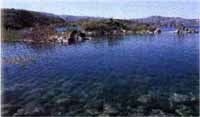 We had not
come to eastern Turkey to see the city of Van, Tuşba, the Muradiye
Falls or Akdamar Island, with their ancient legends, fascinating history
and scenic beauty. Instead, leaving them all behind we headed for Ahlat.
Only Lake Van remained our faithful companion as we drove on, looking
out onto its magical beauty. Referred to as the 'sea' by local people,
Lake Van spans the province of Bitlis to the west and Van to the east.
Ahlat lies on its western shore between the towering mountain of Nemrut
to the southwest and Süphan to the northeast. Behind the town stretches
the plain of Ahlat. Mount Nemrut is the last of Turkey's volcanos ever
to erupt, and it was one of its ancient eruptions which created Lake
Van. The flowing lava petrified to form a natural dam, behind which the
waters collected to form Turkey's largest lake. In the crater of Mount
Nemrut itself is Lake Nemrut, also a record holder as Turkey's deepest
lake.Ahlat
is famed for its Seljuk period mausoleums, whose magnificent
architecture and stone carving have led historians to describe
it as the land of the Seljuk renaissance. These tombs number
among the greatest monuments of early Turkish civilisation in
Anatolia. The history of this region can be traced back to the
15th century
We had not
come to eastern Turkey to see the city of Van, Tuşba, the Muradiye
Falls or Akdamar Island, with their ancient legends, fascinating history
and scenic beauty. Instead, leaving them all behind we headed for Ahlat.
Only Lake Van remained our faithful companion as we drove on, looking
out onto its magical beauty. Referred to as the 'sea' by local people,
Lake Van spans the province of Bitlis to the west and Van to the east.
Ahlat lies on its western shore between the towering mountain of Nemrut
to the southwest and Süphan to the northeast. Behind the town stretches
the plain of Ahlat. Mount Nemrut is the last of Turkey's volcanos ever
to erupt, and it was one of its ancient eruptions which created Lake
Van. The flowing lava petrified to form a natural dam, behind which the
waters collected to form Turkey's largest lake. In the crater of Mount
Nemrut itself is Lake Nemrut, also a record holder as Turkey's deepest
lake.Ahlat
is famed for its Seljuk period mausoleums, whose magnificent
architecture and stone carving have led historians to describe
it as the land of the Seljuk renaissance. These tombs number
among the greatest monuments of early Turkish civilisation in
Anatolia. The history of this region can be traced back to the
15th century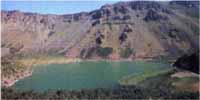 BC. It was ruled in turn by the Assyrians,
Urartians, Medes, Persians, Macedonians, Seleucids, Parthians
and Alatosians, to be followed by the Byzantines, Abbasids and
diverse principalities. Ahlat, anciently Hilat, changed hands
frequently, and was the scene of countless uprisings and
invasions. The Seljuk Turks took Ahlat in 1093, and ruled here
until 1230. This was followed by more
centuries of upheaval,
which lasted until Ahlat became part of the Ottoman Empire after
the Battle of Çaldıran in 1514. So Ahlat is a town which
has seen many peoples come and go, and survived periods of
prosperity and adversity.Two
hours after setting out from Van our coach arrived in Tatvan,
where we halted briefly. The mood of exploration was upon us,
and each of the villages and towns with their own distinct
character that we had passed through had beckoned us to stay and
discover them. In Tatvan we were almost tempted to remain
overnight, but as
BC. It was ruled in turn by the Assyrians,
Urartians, Medes, Persians, Macedonians, Seleucids, Parthians
and Alatosians, to be followed by the Byzantines, Abbasids and
diverse principalities. Ahlat, anciently Hilat, changed hands
frequently, and was the scene of countless uprisings and
invasions. The Seljuk Turks took Ahlat in 1093, and ruled here
until 1230. This was followed by more
centuries of upheaval,
which lasted until Ahlat became part of the Ottoman Empire after
the Battle of Çaldıran in 1514. So Ahlat is a town which
has seen many peoples come and go, and survived periods of
prosperity and adversity.Two
hours after setting out from Van our coach arrived in Tatvan,
where we halted briefly. The mood of exploration was upon us,
and each of the villages and towns with their own distinct
character that we had passed through had beckoned us to stay and
discover them. In Tatvan we were almost tempted to remain
overnight, but as
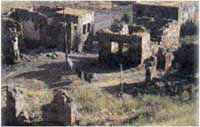 the blue sky was concealed by lowering clouds
we decided to carry on to our final destination of Ahlat without
delay.VDuring
the 45 minute journey to Ahlat we conversed excitedly.
We had heard so much about it, but none of us had ever
been there before. On our arrival we were met by Hasan
Uludağ, director of the town's guest house for
teachers, which since the Selçuk Hotel was closed for
renovation, was for the moment the only place to stay in
Ahlat. We spent four nights there.
the blue sky was concealed by lowering clouds
we decided to carry on to our final destination of Ahlat without
delay.VDuring
the 45 minute journey to Ahlat we conversed excitedly.
We had heard so much about it, but none of us had ever
been there before. On our arrival we were met by Hasan
Uludağ, director of the town's guest house for
teachers, which since the Selçuk Hotel was closed for
renovation, was for the moment the only place to stay in
Ahlat. We spent four nights there.
The next morning we set out to see the renowned
mausoleums, known as kümbet, nineteen of which are
scattered over the area. Some stand by the road, some at
the edge of fields, others in peoplsre gardens or on
hilltops. These centuries old buildings are among the
finest examples of Seljuk architecture, and the final
resting places of many eminent figures of the period.
Most of the kümbets have a square base above which is a
polygonal drum supporting a cylindrical body, covered by
a conical roof with an interior cupola.
A few, such as
that of Şeyh Necmeddin, are square. One
of the most distinctive kümbets is that of Emir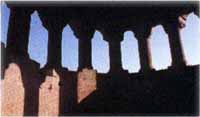 Bayındır,
encircled by short columns linked by arches. Among those
most renowned for their ornate carving are Usta Şagirt
Kümbet (Ulu Kümbet) dated 1273, the Hasan Padişah
Kümbet and Double Kümbets dating from around the same
time, the Hüseyin Timur Kümbet (1279) and Bugatay Aka
Kümbet (1281).As we went from one
to the other, we felt as if we had travelled back in time. Most
had richly decorated portals, carved in relief with dragons,
geometric and floriate motifs, and inscriptions.
Bayındır,
encircled by short columns linked by arches. Among those
most renowned for their ornate carving are Usta Şagirt
Kümbet (Ulu Kümbet) dated 1273, the Hasan Padişah
Kümbet and Double Kümbets dating from around the same
time, the Hüseyin Timur Kümbet (1279) and Bugatay Aka
Kümbet (1281).As we went from one
to the other, we felt as if we had travelled back in time. Most
had richly decorated portals, carved in relief with dragons,
geometric and floriate motifs, and inscriptions.
The Seljuk graveyard at Ahlat is another extraordinary sight.
Here the graves are marked not by kümbets, but by great stones
2 metres in height, known locally as akıt. Like the kümbets,
the stone carving on these tombstones is remarkable, turning the
cemetery into an openair museum. No two are alike, and for hours
we wandered from one to the other.On the days that
remained to us we visited the ancient ruined city, the Ottoman castle whose
construction commenced during the reign of Sultan Süleyman the
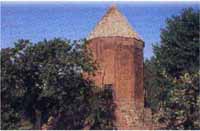 Magnificent
(1520-1566) and was completed during the reign of his son Selim II (1566-1574),
Ahlat Museum and other sights.hlat is a town
with a population of over ten thousand which sprawls along its 5
kilometre long main street, Sanayi Caddesi. Seated on small stools
outside the coffee houses and shops along here we got to know the town's
modern inhabitants over our glasses of strong tea. Behind the main
street are the charming one and two storey houses built of local Ahlat
stone, and almost buried in green foliage. Each house has a large garden
planted with mainly apricot, cherry, walnut and plum trees, and
surrounded by a wall of the same stone. As we wandered around we were
offered fruit by the women, who spend their lives behind these walls.The economy of Ahlat is based on farming and animal husbandry, but it is
also famous still for its stone and stone masons. As well as the Ahlat
stone, pumice is quarried in the region. With its spectacular setting on
Lake Van, Mount Nemrut, fascinating historic monuments, and friendly
Magnificent
(1520-1566) and was completed during the reign of his son Selim II (1566-1574),
Ahlat Museum and other sights.hlat is a town
with a population of over ten thousand which sprawls along its 5
kilometre long main street, Sanayi Caddesi. Seated on small stools
outside the coffee houses and shops along here we got to know the town's
modern inhabitants over our glasses of strong tea. Behind the main
street are the charming one and two storey houses built of local Ahlat
stone, and almost buried in green foliage. Each house has a large garden
planted with mainly apricot, cherry, walnut and plum trees, and
surrounded by a wall of the same stone. As we wandered around we were
offered fruit by the women, who spend their lives behind these walls.The economy of Ahlat is based on farming and animal husbandry, but it is
also famous still for its stone and stone masons. As well as the Ahlat
stone, pumice is quarried in the region. With its spectacular setting on
Lake Van, Mount Nemrut, fascinating historic monuments, and friendly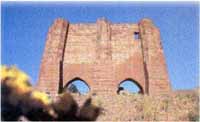 inhabitants Ahlat more than repaid our curiosity.
inhabitants Ahlat more than repaid our curiosity.
We ended our sightseeing with a visit to Lake Nazik, accompanied by
local journalist Mehmet Ali Köprücü. Like Lake Van this was also
formed by a lava dam. The views were superb, and we did not return until
we had watched the sun set over the beautiful landscape. The
exhilaration of seeing new places and making new friends was now mingled
with the sadness of departure, but we were taking with us wonderful
memories of Ahlat.
![]()
Home | Ana
Sayfa | All About Turkey | Turkiye
hakkindaki Hersey | Turkish Road Map
| Historical Places in Adiyaman | Historical
Places in Turkey | Mt.Nemrut | Slide
Shows | Related Links | Guest
Book | Disclaimer | Send a Postcard | Travelers' Stories | Donate a little to help | Getting Around Istanbul | Adiyaman Forum
|
|